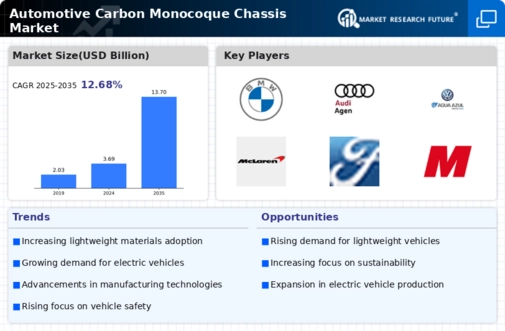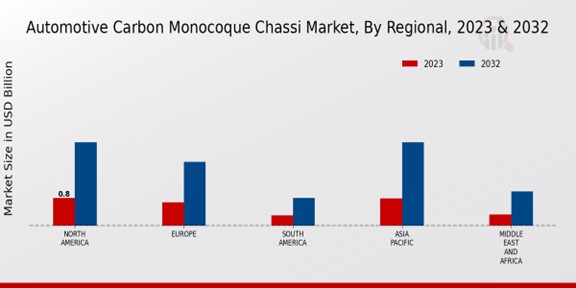Market Growth Projections
The Global Automotive Carbon Monocoque Chassis Market Industry is projected to experience robust growth over the coming years. With a market value of 3.69 USD Billion in 2024, it is expected to escalate to 13.7 USD Billion by 2035. This growth trajectory indicates a compound annual growth rate (CAGR) of 12.68% from 2025 to 2035. Such projections reflect the increasing adoption of carbon monocoque chassis across various automotive segments, driven by technological advancements, regulatory pressures, and shifting consumer preferences. The market's expansion underscores the potential for innovation and investment in this sector.
Increasing Electric Vehicle Adoption
The Global Automotive Carbon Monocoque Chassis Market Industry is poised for growth due to the increasing adoption of electric vehicles (EVs). As automakers shift their focus towards EV production, the need for lightweight and efficient chassis becomes paramount. Carbon monocoque chassis offer the necessary structural integrity while contributing to the overall weight reduction of electric vehicles, thus enhancing their range and performance. This trend is likely to accelerate, with the market anticipated to grow at a CAGR of 12.68% from 2025 to 2035. The integration of carbon chassis in EVs not only improves efficiency but also aligns with global sustainability goals.
Rising Demand for Lightweight Vehicles
The Global Automotive Carbon Monocoque Chassis Market Industry is experiencing a surge in demand for lightweight vehicles, driven by the need for improved fuel efficiency and reduced emissions. As consumers become increasingly environmentally conscious, manufacturers are compelled to adopt materials that enhance performance while minimizing weight. Carbon monocoque chassis, known for their strength-to-weight ratio, are becoming a preferred choice. In 2024, the market is projected to reach 3.69 USD Billion, reflecting the growing trend towards sustainable automotive solutions. This shift not only aligns with regulatory pressures but also caters to consumer preferences for eco-friendly vehicles.
Technological Advancements in Manufacturing
Technological innovations in the production of carbon monocoque chassis are significantly influencing the Global Automotive Carbon Monocoque Chassis Market Industry. Advanced manufacturing techniques, such as automated fiber placement and 3D printing, enable manufacturers to produce complex designs with greater precision and efficiency. These advancements reduce production costs and time, making carbon chassis more accessible to a broader range of automotive manufacturers. As a result, the market is expected to grow substantially, with projections indicating a rise to 13.7 USD Billion by 2035. This growth underscores the potential of technology to transform traditional manufacturing processes in the automotive sector.
Regulatory Pressures for Emission Reductions
Regulatory frameworks aimed at reducing vehicle emissions are driving the Global Automotive Carbon Monocoque Chassis Market Industry. Governments worldwide are implementing stringent emission standards, compelling manufacturers to innovate and adopt lighter materials that contribute to lower emissions. Carbon monocoque chassis, with their lightweight properties, are increasingly viewed as a viable solution to meet these regulations. As the automotive industry adapts to these changes, the demand for carbon chassis is expected to rise, further solidifying their role in the market. This regulatory environment fosters a competitive landscape where innovation is essential for compliance and market success.
Consumer Preference for Performance and Safety
Consumer preferences are evolving towards vehicles that offer enhanced performance and safety features, significantly impacting the Global Automotive Carbon Monocoque Chassis Market Industry. The inherent properties of carbon monocoque chassis, such as superior crashworthiness and rigidity, appeal to safety-conscious consumers. Additionally, the lightweight nature of these chassis contributes to improved handling and acceleration, aligning with consumer desires for high-performance vehicles. As automakers respond to these preferences, the market is likely to witness substantial growth, driven by the integration of carbon chassis in new vehicle models.



















